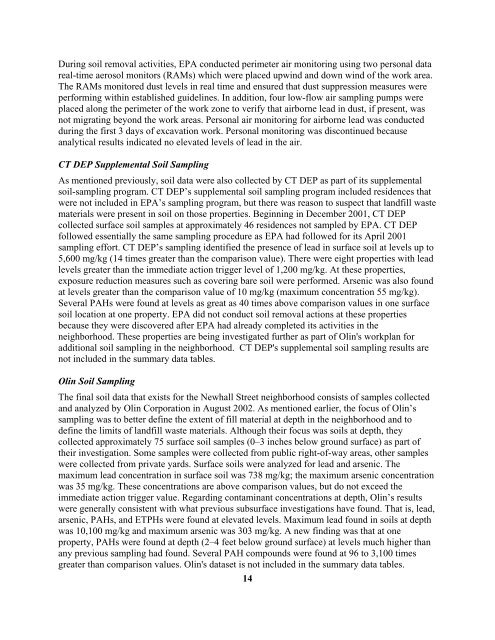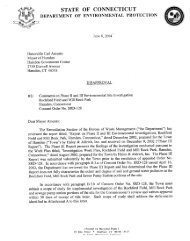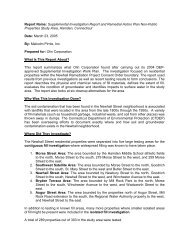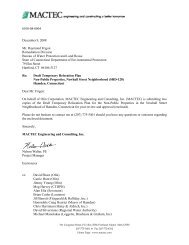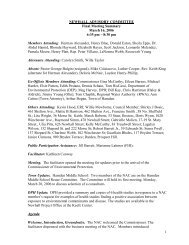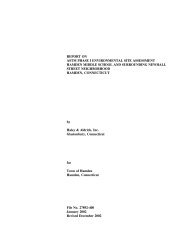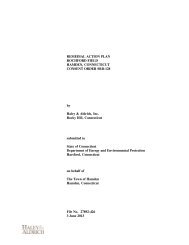Main Report - Newhall Remediation Project
Main Report - Newhall Remediation Project
Main Report - Newhall Remediation Project
- No tags were found...
Create successful ePaper yourself
Turn your PDF publications into a flip-book with our unique Google optimized e-Paper software.
During soil removal activities, EPA conducted perimeter air monitoring using two personal datareal-time aerosol monitors (RAMs) which were placed upwind and down wind of the work area.The RAMs monitored dust levels in real time and ensured that dust suppression measures wereperforming within established guidelines. In addition, four low-flow air sampling pumps wereplaced along the perimeter of the work zone to verify that airborne lead in dust, if present, wasnot migrating beyond the work areas. Personal air monitoring for airborne lead was conductedduring the first 3 days of excavation work. Personal monitoring was discontinued becauseanalytical results indicated no elevated levels of lead in the air.CT DEP Supplemental Soil SamplingAs mentioned previously, soil data were also collected by CT DEP as part of its supplementalsoil-sampling program. CT DEP’s supplemental soil sampling program included residences thatwere not included in EPA’s sampling program, but there was reason to suspect that landfill wastematerials were present in soil on those properties. Beginning in December 2001, CT DEPcollected surface soil samples at approximately 46 residences not sampled by EPA. CT DEPfollowed essentially the same sampling procedure as EPA had followed for its April 2001sampling effort. CT DEP’s sampling identified the presence of lead in surface soil at levels up to5,600 mg/kg (14 times greater than the comparison value). There were eight properties with leadlevels greater than the immediate action trigger level of 1,200 mg/kg. At these properties,exposure reduction measures such as covering bare soil were performed. Arsenic was also foundat levels greater than the comparison value of 10 mg/kg (maximum concentration 55 mg/kg).Several PAHs were found at levels as great as 40 times above comparison values in one surfacesoil location at one property. EPA did not conduct soil removal actions at these propertiesbecause they were discovered after EPA had already completed its activities in theneighborhood. These properties are being investigated further as part of Olin's workplan foradditional soil sampling in the neighborhood. CT DEP's supplemental soil sampling results arenot included in the summary data tables.Olin Soil SamplingThe final soil data that exists for the <strong>Newhall</strong> Street neighborhood consists of samples collectedand analyzed by Olin Corporation in August 2002. As mentioned earlier, the focus of Olin’ssampling was to better define the extent of fill material at depth in the neighborhood and todefine the limits of landfill waste materials. Although their focus was soils at depth, theycollected approximately 75 surface soil samples (0–3 inches below ground surface) as part oftheir investigation. Some samples were collected from public right-of-way areas, other sampleswere collected from private yards. Surface soils were analyzed for lead and arsenic. Themaximum lead concentration in surface soil was 738 mg/kg; the maximum arsenic concentrationwas 35 mg/kg. These concentrations are above comparison values, but do not exceed theimmediate action trigger value. Regarding contaminant concentrations at depth, Olin’s resultswere generally consistent with what previous subsurface investigations have found. That is, lead,arsenic, PAHs, and ETPHs were found at elevated levels. Maximum lead found in soils at depthwas 10,100 mg/kg and maximum arsenic was 303 mg/kg. A new finding was that at oneproperty, PAHs were found at depth (2–4 feet below ground surface) at levels much higher thanany previous sampling had found. Several PAH compounds were found at 96 to 3,100 timesgreater than comparison values. Olin's dataset is not included in the summary data tables.14


